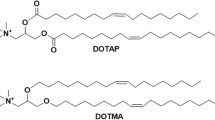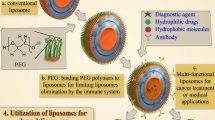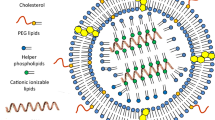Abstract
In this study, co-delivery system was achieved via plasmid encoding TNF related apoptosis inducing ligand (pTRAIL) and doxorubicin (DOX) using carrier based on polypropylenimine (PPI) modified with 10-bromodecanoic acid. Incorporation of alkylcarboxylate chain to PPIs (G4 and G5) could improve transfection efficiency via overcoming the plasma membrane barrier of the cells and decrease cytotoxicity of PPI. Characterization of fabricated NPs revealed that PPI G5 in which 30% of primary amines were substituted by alkyl carboxylate chain (PPI G5-Alkyl 30%) has higher drug loading as compared to the other formulations. PPI G5-Alkyl 30% indicated a decreased drug release may be due to alkyl chains on the surface of PPI, which serve as an additional hindrance for drug diffusion. In vitro cytotoxicity experiments demonstrated that co-delivery system induced apoptosis of tumor cells more efficiently than each of delivery system alone. Furthermore, these results revealed that our combined delivery platform of pTRAIL and DOX using Alkyl-modified PPI G5 can significantly improve the anti-tumor activity and this strategy might develop a new therapeutic window for cancer treatment.









Similar content being viewed by others
References
Saraswathy M, Gong S. Recent developments in the co-delivery of siRNA and small molecule anticancer drugs for cancer treatment. Mater Today. 2014;17(6):298–306.
Yang Z, Gao D, Cao Z, Zhang C, Cheng D, Liu J, et al. Drug and gene co-delivery systems for cancer treatment. Biomater Sci. 2015;3(7):1035–49.
Guan X, Li Y, Jiao Z, Lin L, Chen J, Guo Z, et al. Codelivery of antitumor drug and gene by a pH-sensitive charge-conversion system. ACS Appl Mater Interfaces. 2015;7(5):3207–15.
Khan M, Ong ZY, Wiradharma N, Attia ABE, Yang YY. Advanced materials for co-delivery of drugs and genes in cancer therapy. Adv Healthc Mater. 2012;1(4):373–92.
Taghavi S, Nia AH, Abnous K, Ramezani M. Polyethylenimine-functionalized carbon nanotubes tagged with AS1411 aptamer for combination gene and drug delivery into human gastric cancer cells. Int J Pharm. 2017;516(1):301–12.
Wang S, Konorev EA, Kotamraju S, Joseph J, Kalivendi S, Kalyanaraman B. Doxorubicin induces apoptosis in normal and tumor cells via distinctly different mechanisms intermediacy of H2O2-and p53-dependent pathways. J Biol Chem. 2004;279(24):25535–43.
Han Y, Zhang P, Chen Y, Sun J, Kong F. Co-delivery of plasmid DNA and doxorubicin by solid lipid nanoparticles for lung cancer therapy. Int J Mol Med. 2014;34(1):191–6.
Liu C, Liu F, Feng L, Li M, Zhang J, Zhang N. The targeted co-delivery of DNA and doxorubicin to tumor cells via multifunctional PEI-PEG based nanoparticles. Biomaterials. 2013;34(10):2547–64.
Zhao J, Feng S-S. Nanocarriers for delivery of siRNA and co-delivery of siRNA and other therapeutic agents. Nanomedicine. 2015;10(14):2199–228.
Liu S, Guo Y, Huang R, Li J, Huang S, Kuang Y, et al. Gene and doxorubicin co-delivery system for targeting therapy of glioma. Biomaterials. 2012;33(19):4907–16.
Wang C, Li M, Yang T, Ding X, Bao X, Ding Y, et al. A self-assembled system for tumor-targeted co-delivery of drug and gene. Mater Sci Eng C. 2015;56:280–5.
Liu F, Shollenberger LM, Huang L. Non-immunostimulatory nonviral vectors. FASEB J. 2004;18(14):1779–81.
Kim E, Jung Y, Choi H, Yang J, Suh JS, Huh YM, et al. Prostate cancer cell death produced by the co-delivery of Bcl-xL shRNA and doxorubicin using an aptamer-conjugated polyplex. Biomaterials. 2010;31(16):4592–9.
Zhu C, Jung S, Luo S, Meng F, Zhu X, Park TG, et al. Co-delivery of siRNA and paclitaxel into cancer cells by biodegradable cationic micelles based on PDMAEMA-PCL-PDMAEMA triblock copolymers. Biomaterials. 2010;31(8):2408–16.
Ebrahimian M, Taghavi S, Mokhtarzadeh A, Ramezani M, Hashemi M. Co-delivery of doxorubicin encapsulated PLGA nanoparticles and Bcl-xL shRNA using alkyl-modified PEI into breast cancer cells. Appl Biochem Biotechnol. 2017;183(1):126–36.
Wang Y, Gao S, Ye WH, Yoon HS, Yang YY. Co-delivery of drugs and DNA from cationic core–shell nanoparticles self-assembled from a biodegradable copolymer. Nat Mater. 2016;5(10):791–6.
Hashemi M, Parhiz H, Mokhtarzadeh A, Tabatabai SM, Farzad SA, Shirvan HR, et al. Preparation of effective and safe gene carriers by grafting alkyl chains to generation 5 polypropyleneimine. AAPS PharmSciTech. 2015;16(5):1002–12.
Menjoge AR, Kannan RM, Tomalia DA. Dendrimer-based drug and imaging conjugates: design considerations for nanomedical applications. Drug Discov Today. 2010;15(5–6):171–85.
Tripathy S, Das MK. Dendrimers and their applications as novel drug delivery carriers. J Appl Pharm Sci. 2013;3(9):142–9.
Wang F, Cai X, Su Y, Hu J, Wu Q, Zhang H, et al. Reducing cytotoxicity while improving anti-cancer drug loading capacity of polypropylenimine dendrimers by surface acetylation. Acta Biomater. 2012;8(12):4304–13.
Richter-Egger DL, Tesfai A, Tucker SA. Spectroscopic investigations of poly(propyleneimine)dendrimers using the solvatochromic probe phenol blue and comparisons to poly(amidoamine) dendrimers. Anal Chem. 2001;73(23):5743–51.
Cheng Y, Xu T. The effect of dendrimers on the pharmacodynamic and pharmacokinetic behaviors of non-covalently or covalently attached drugs. Eur J Med Chem. 2008;43(11):2291–7.
Han M, Lv Q, Tang X-J, Hu Y-L, Xu D-H, Li F-Z, et al. Overcoming drug resistance of MCF-7/ADR cells by altering intracellular distribution of doxorubicin via MVP knockdown with a novel siRNA polyamidoamine-hyaluronic acid complex. J Control Release. 2012;163(2):136–44.
Hashemi M, Tabatabai SM, Parhiz H, Milanizadeh S, Farzad SA, Abnous K, et al. Gene delivery efficiency and cytotoxicity of heterocyclic amine-modified PAMAM and PPI dendrimers. Mater Sci Eng C. 2016;61:791–800.
Santos JL, Oliveira H, Pandita D, Rodrigues J, Pêgo AP, Granja PL, et al. Functionalization of poly(amidoamine) dendrimers with hydrophobic chains for improved gene delivery in mesenchymal stem cells. J Control Release. 2010;144(1):55–64.
Shao N, Su Y, Hu J, Zhang J, Zhang H, Cheng Y. Comparison of generation 3 polyamidoamine dendrimer and generation 4 polypropylenimine dendrimer on drug loading, complex structure, release behavior, and cytotoxicity. Int J Nanomedicine. 2011;6:3361–72.
Wang C, Chen T, Zhang N, Yang M, Li B, Lu X, et al. Melittin, a major component of bee venom, sensitizes human hepatocellular carcinoma cells to tumor necrosis factor-related apoptosis-inducing ligand (TRAIL)-induced apoptosis by activating CaMKII-TAK1-JNK/p38 and inhibiting IkappaBalpha kinase-NFkappaB. J Biol Chem. 2009;284(6):3804–13.
Holoch PA, Griffith TS. TNF-related apoptosis-inducing ligand (TRAIL): a new path to anti-cancer therapies. Eur J Pharmacol. 2009;625(1–3):63–72.
Hashemi M, Sahraie Fard H, Amel Farzad S, Parhiz H, Ramezani M. Gene transfer enhancement by alkylcarboxylation of poly (propylenimine). Nanomedicine J. 2013;1(1):55–62.
Huihui Liao HL, Li Y, Zhang M, Tomas H, Shen M, Shi X. Antitumor efficacy of doxorubicin encapsulated within PEGylated poly(amidoamine) dendrimers. J Appl Polym Sci. 2014;131(11):1–10.
Zhu J, Xiong Z, Shen M, Shi X. Encapsulation of doxorubicin within multifunctional gadolinium-loaded dendrimer nanocomplexes for targeted theranostics of cancer cells. RSC Adv. 2015;5:30286–96.
Taghavi S, HashemNia A, Mosaffa F, Askarian S, Abnous K, Ramezani M. Preparation and evaluation of polyethylenimine-functionalized carbon nanotubes tagged with 5TR1 aptamer for targeted delivery of Bcl-xL shRNA into breast cancer cells. Colloids Surf B: Biointerfaces. 2016;140:28–39.
Martinho N, Florindo H, Silva L, Brocchini S, Zloh M, Barata T. Molecular modeling to study dendrimers for biomedical applications. Molecules. 2014;19(12):20424.
Han L, Huang R, Li J, Liu S, Huang S, Jiang C. Plasmid pORF-hTRAIL and doxorubicin co-delivery targeting to tumor using peptide-conjugated polyamidoamine dendrimer. Biomaterials. 2011;32(4):1242–52.
Schneider-Jakob S, Corazza N, Badmann A, Sidler D, Stuber-Roos R, Keogh A, et al. Synergistic induction of cell death in liver tumor cells by TRAIL and chemotherapeutic drugs via the BH3-only proteins Bim and Bid. Cell Death Dis. 2010;1:e86.
Fant K, Esbjorner EK, Jenkins A, Grossel MC, Lincoln P, Norden B. Effects of PEGylation and acetylation of PAMAM dendrimers on DNA binding, cytotoxicity and in vitro transfection efficiency. Mol Pharm. 2010;7(5):1734–46.
Liu Z, Zhang Z, Zhou C, Jiao Y. Hydrophobic modifications of cationic polymers for gene delivery. Prog Polym Sci. 2010;35(9):1144–62.
Author information
Authors and Affiliations
Corresponding author
Rights and permissions
About this article
Cite this article
Ebrahimian, M., Taghavi, S., Ghoreishi, M. et al. Evaluation of Efficiency of Modified Polypropylenimine (PPI) with Alkyl Chains as Non-viral Vectors Used in Co-delivery of Doxorubicin and TRAIL Plasmid. AAPS PharmSciTech 19, 1029–1036 (2018). https://doi.org/10.1208/s12249-017-0913-z
Received:
Accepted:
Published:
Issue Date:
DOI: https://doi.org/10.1208/s12249-017-0913-z




